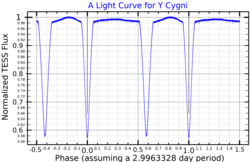| Observation data Epoch J2000 Equinox J2000 | |
|---|---|
| Constellation | Cygnus |
| Right ascension | 20h 52m 3.57718s [2] |
| Declination | +34° 39′ 27.4861″ [2] |
| Apparent magnitude (V) | 7.3 - 7.9 [3] |
| Characteristics | |
| Primary | |
| Spectral type | O9.5V [4] |
| Apparent magnitude (U) | 5.91[ citation needed] |
| Apparent magnitude (B) | 6.996[ citation needed] |
| Apparent magnitude (V) | 7.287 [4] |
| U−B color index | −1.086 [4] |
| B−V color index | −0.291 [4] |
| Secondary | |
| Spectral type | O9.5V [4] |
| Apparent magnitude (U) | 5.883[ citation needed] |
| Apparent magnitude (B) | 6.974[ citation needed] |
| Apparent magnitude (V) | 7.265 [4] |
| U−B color index | −1.091 [4] |
| B−V color index | −0.291 [4] |
| Variable type | Algol [3] |
| Astrometry | |
| Proper motion (μ) |
RA: +2.763
[2]
mas/
yr Dec.: −15.981 [2] mas/ yr |
| Parallax (π) | 0.6759 ± 0.0338 mas [2] |
| Distance | 4,900
ly (1,500 [4] pc) |
| Absolute magnitude (MV) | −3.59/−3.62 [4] |
|
Absolute bolometric magnitude (Mbol) | −6.65±0.04/−6.7±0.04 [4] |
| Orbit [4] | |
| Primary | Y Cyg A |
| Companion | Y Cyg B |
| Period (P) | 2.99633210±0.00000031 d |
| Semi-major axis (a) | 28.72 R☉ |
| Eccentricity (e) | 0.14508 |
| Inclination (i) | 86.474±0.019° |
| Periastron epoch (T) | 2,446,308.66407±0.0001 |
|
Argument of periastron (ω) (secondary) | 312.514° |
|
Argument of periastron (ω) (primary) | 132.514±0.052° |
| Details [4] | |
| Primary | |
| Mass | 17.72±0.35 M☉ |
| Radius | 5.785±0.091 R☉ |
| Luminosity | 36,000 L☉ |
| Surface gravity (log g) | 4.161±0.014 cgs |
| Temperature | 33,200±200 K |
| Rotational velocity (v sin i) | 132 km/s |
| Age | 2 Myr |
| Secondary | |
| Mass | 17.73±0.3 M☉ |
| Radius | 5.816±0.063 R☉ |
| Luminosity | 37,700 L☉ |
| Surface gravity (log g) | 4.157±0.01 cgs |
| Temperature | 33,521±40 K |
| Rotational velocity (v sin i) | 132 km/s |
| Age | 2 Myr |
| Other designations | |
| Database references | |
| SIMBAD | data |
Y Cygni is an eclipsing and double-lined spectroscopic binary star system in the constellation of Cygnus. It is located about 4,900 light-years from Earth. The system was one of the first binaries with a convincing detection of the apsidal precession. [4]
The two stars, being O-type main-sequence stars, orbit each other with a period of nearly 3 days. [4]
Observation history
The early type of Y Cyg made it a popular target for astronomers in the past, and spectroscopic orbits have been historically computed numerous times. [5] The first of these studies was published in 1920 by John Stanley Plaskett. [6] Extensive spectroscopic studies of Y Cyg were carried out as early as 1930. [7] Several follow-ups to these have been published in 1959, [8] 1971, [9] [10] and 1980. [11] The latter of these contained an estimate of the period of apsidal precession.
References
- ^ "MAST: Barbara A. Mikulski Archive for Space Telescopes". Space Telescope Science Institute. Retrieved 8 December 2021.
- ^ a b c d e Vallenari, A.; et al. (Gaia collaboration) (2023). "Gaia Data Release 3. Summary of the content and survey properties". Astronomy and Astrophysics. 674: A1. arXiv: 2208.00211. Bibcode: 2023A&A...674A...1G. doi: 10.1051/0004-6361/202243940. S2CID 244398875. Gaia DR3 record for this source at VizieR.
- ^ a b Samus, N. N.; Durlevich, O. V.; et al. (2009). "VizieR Online Data Catalog: General Catalogue of Variable Stars (Samus+ 2007-2013)". VizieR On-line Data Catalog: B/GCVS. Originally Published in: 2009yCat....102025S. 1: B/gcvs. Bibcode: 2009yCat....102025S.
- ^ a b c d e f g h i j k l m n o Harmanec, P.; Holmgren, D. E.; Wolf, M.; Božić, H.; Guinan, E. F.; Kang, Y. W.; Mayer, P.; McCook, G. P.; Nemravová, J.; Yang, S.; Šlechta, M.; Ruždjak, D.; Sudar, D.; Svoboda, P. (March 2014). "Revised physical elements of the astrophysically important O9.5+O9.5V eclipsing binary system Y Cygni". Astronomy and Astrophysics. 563: A120. arXiv: 1403.0721. Bibcode: 2014A&A...563A.120H. doi: 10.1051/0004-6361/201323230. ISSN 0004-6361. S2CID 118651473.
- ^ Hill, G.; Holmgren, D. E. (May 1995). "Studies of early-type variable stars. IX. Y Cygni". Astronomy and Astrophysics. 297: 127–134. Bibcode: 1995A&A...297..127H.
- ^ Jones, Harold Spencer (1 November 1942). "John Stanley Plaskett, 1865-1941". The Royal Society. 4 (11): 67–82. doi: 10.1098/rsbm.1942.0007.
- ^ Redman, R. O. (August 1930). "Y Cygni". The Astronomical Society of the Pacific. 42: 250. Bibcode: 1930PASP...42..250R. doi: 10.1086/124047. S2CID 250785748.
- ^ Struve, O.; Sahade, J.; Zabergs, V. (January 1959). "Y Cygni". Astrophysical Journal. 129: 59. Bibcode: 1959ApJ...129...59S. doi: 10.1086/146595.
- ^ Vitrichenko, E. A. (1971). "The improvement of the Spectroscopic orbit of Y Cyg". Società Astronomia Italiana. 43: 71. Bibcode: 1972MmSAI..43...71V.
- ^ Vitrichenko, E. A. (1971). "The improvement of the Spectroscopic orbit of Y Cyg". Izv. Krym. Astrofiz. Obs. 43: 71–75. Bibcode: 1971IzKry..43...71V.
- ^ Gimenez, A.; Costa, V. (December 1980). "Y CYG : photometry and apsidal motion". The Astronomical Society of the Pacific. 92: 782–784. Bibcode: 1980PASP...92..782G. doi: 10.1086/130747. S2CID 120757652.
